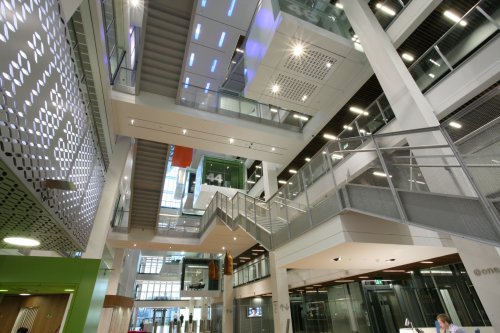Project: Environmentally sustainable lighting in office complex
Friday, 26 March, 2010
One Shelley Street, the new Sydney premise of the Macquarie Group, was developed by Brookfield Multiplex to set new standards in sustainable office design. The building boasts many environmental initiatives that saw it awarded the Green Building Council of Australia’s 6-Star Green Star - Office Design v2 Certified Rating, representative of ‘world leadership’ in environmentally sustainable design and/or construction.

The use of light - both natural and artificial - plays a key role in accreditation. The innovative building design by architects fitzpatrick+partners includes a facade and central atrium that promotes natural light ingress. This is complemented by an advanced lighting energy management system, conceptualised by lighting designers Vision Design (a specialist service of WSP Lincolne Scott) and founded on a lighting control system from Philips Dynalite.
Most of the 11-level, 33,000 m2 premise is open-plan office areas, with multiple meeting-room ‘pods’ jutting into a central atrium cavity, several board and multimedia rooms, two cafeterias, plus kitchens and amenities on each level. A centralised control system from Philips Dynalite manages lighting energy consumption for the entire building.

Donn Salisbury, WSP Lincolne Scott Associate and head of Vision Design in Sydney, adds: “The lighting design incorporates several strategies to optimise energy consumption. A distributed single-lamp solution was selected for office areas, utilising high-performance luminaires incorporating 16 mm T5 linear fluorescents to achieve the required uniform lux levels (320-400 lux). The resulting light power density is just over 5 W/m2.”
Using a combination of motion and light sensors and timed events, the control system permits lighting levels to be tailored to the use of space, enabling total flexibility for zone switching and dimming and ensuring no areas are overlit or illuminated when not in use.
A key consideration in sustainable commercial fitouts is making sure the building will accommodate reconfiguration as tenancy requirements change. This means the lighting solution needs to cater for a multitude of different scenarios and be easily configurable.
To ensure the required level of flexibility, a DALI data protocol and transport mechanism is used in the main open office areas. Up to 64 individually addressable DALI devices can be controlled by a single network (or ‘universe’), while control groups/zones can be configured and reconfigured from a computer, without reconfiguring the fittings themselves.
Salisbury continues: “The Philips Dynalite DDBC320 DALI controller is the only controller on the market that can control three DALI universes - up to 192 ballasts/devices per controller. All the DALI ballasts can be individually controlled, depending on how you set up the zones. There’s ultimate flexibility to cater for tenant functionality and environmental influences.”
Anthony Seddon, the Philips Dynalite NSW State Manager, adds: “The controller powers down the DALI universe when not in use. With most DALI systems, all the ballasts have to be powered up all the time. But with this system, there’s no wasted energy.”
The Philips Dynalite MapView graphical user interface provides a visual schematic of the entire lighting system, plus allows easy configuration of timed events and facilitates scene adjustments.
“The intelligent lighting system is one of the key sustainability initiatives used in this building,” says Nani Melwani, Services Manager for Brookfield Multiplex. “The software makes it very easy to reconfigure zones on each floor.”
Salisbury too is a fan of MapView: “Other systems are nowhere near this level. It’s incredibly simple for end users - the building manager can see what’s connected floor by floor and access any part of the system with a sweep of the mouse.”
Other important areas also controlled by the integrated lighting system include LED architectural lighting in the central atrium lobby areas and adjoining multifunction room; DSI control of lighting and blinds in various meeting/board rooms; and relay control of lights used in public/amenities areas. The system, which was engineered and installed by HeyDay Electrical, also supports integration with third-party AV systems in meeting rooms.
The entire lighting control system is founded on Philips Dynalite’s peer-to-peer communications serial bus network, DyNet, which links the multitude of controllers with over 300 multifunction sensors and 75 LCD touch screens throughout the building.
Although it is too early in the building’s life to quantify the energy savings of the lighting control system - which are predicted to be significant - its contribution to the Green Star certification was appreciable.
Tackling EV misinformation at Everything Electric
Lauren Davis discusses all things EV with Robert Llewellyn, Red Dwarf cast member...
Let's talk about electrification, digitalisation and decarbonisation
Can the building sector use AI tools as a binding force for different energy efficiency processes?
A connected world: how smart systems are enhancing sustainability
The drive for smarter, smoother, more efficient connected and integrated infrastructure is often...




